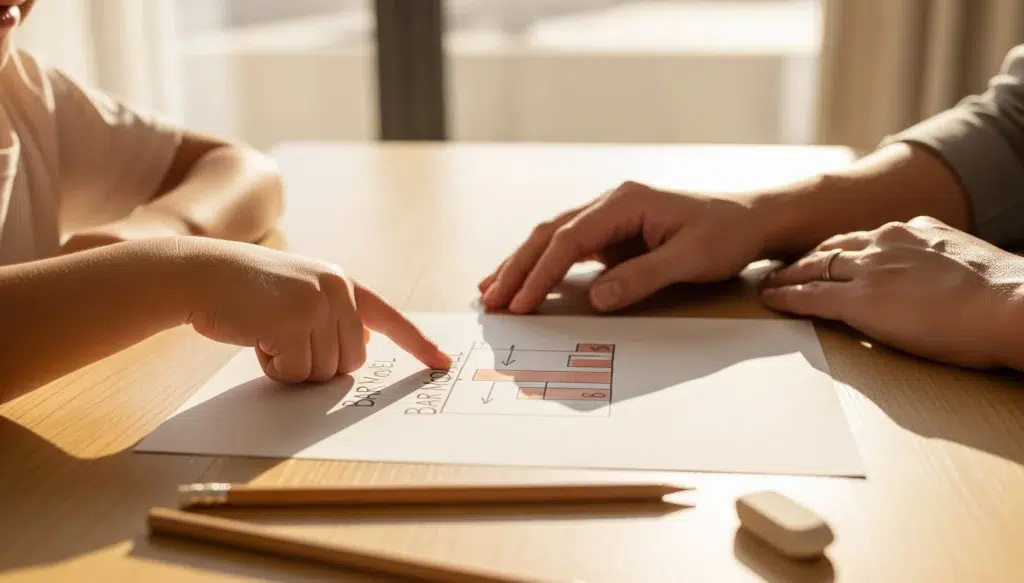Solving Word Problems in Primary Maths: The Bar Model Method Explained
If you’re a parent of a primary schooler in Dubai, you’ve likely seen a maths homework problem that looks something like this:
“Ali has 15 more stickers than Fatima. Together, they have 61 stickers. How many stickers does Ali have?”
Your first instinct might be to reach for algebra (x + y = 61, x = y + 15). But your child hasn’t learned algebra yet. Instead, their teacher is encouraging them to draw a series of rectangles. Welcome to the Bar Model Method.

If this “new” way of doing maths leaves you feeling confused or unable to help with homework, you are not alone. The Bar Model, a cornerstone of the world-renowned Singapore Maths approach, is a visual and intuitive way to solve complex word problems without formal algebra.
This guide will demystify the Bar Model for you. We’ll walk you through the logic, the diagrams, and the step-by-step process so you can confidently support your child and see why this method is so powerful.
What is the Bar Model Method?
The Bar Model Method is not about calculation; it’s about understanding. It’s a problem-solving strategy that uses rectangular bars to represent numbers and the relationships between them.
Instead of just seeing numbers on a page, children draw and label these bars to visualize the problem. This act of drawing turns an abstract word problem into a concrete, manageable picture, help
The Two Key Types of Bar Models
Almost all primary-level word problems can be solved using one of two simple bar models.
1. The Part-Whole Model (for Addition and Subtraction)
This model is used when you are trying to find a whole number or one of its parts.
Example Problem: “There are 25 students in Class 3A and 28 students in Class 3B. How many students are there in total?”
How to Draw It:
Draw a bar to represent the first part (Class 3A). Label it ’25’.
Draw another bar next to it to represent the second part (Class 3B). Label it ’28’.
Draw a third, longer bar above or below the first two, representing the ‘Whole’ or the ‘Total’. This is the unknown we need to find, so we label it with a ‘?’.
[Simple diagram showing a bar for ’25’, a bar for ’28’, and a longer bar underneath labelled ‘?’]
By visualizing the problem, a child can clearly see that the two ‘parts’ (25 and 28) need to be added together to find the ‘whole’.
Calculation: 25 + 28 = 53.
This same model works for subtraction. If you know the whole (53) and one part (25), you can see that you need to subtract to find the other part.
2. The Comparison Model (for Finding the Difference)
This model is used when the problem involves comparing two different quantities. This is where the Bar Model truly shines. Let’s go back to our first problem.
Example Problem: “Ali has 15 more stickers than Fatima. Together, they have 61 stickers. How many stickers does Ali have?”
How to Draw It:
Draw a bar for Fatima. We don’t know how many she has, so it’s an unknown unit.
Draw a bar for Ali directly underneath. We know Ali has the same amount as Fatima, plus an extra 15. So, we draw an identical bar to Fatima’s and add a smaller bar next to it, which we label ’15’.
We know the total is 61. We represent this with a bracket covering both of Ali’s and Fatima’s bars.
[Diagram showing Fatima’s bar (unknown), Ali’s bar (unknown + 15), and a total bracket of 61]
How to Solve It Visually:
Looking at the model, the first step is clear: take the total (61) and subtract the extra bit (15).
61 – 15 = 46
What does this ’46’ represent? It represents the two equal, unknown bars (Fatima’s bar and the first part of Ali’s bar).
If two equal bars make 46, then one bar must be half of that.
46 ÷ 2 = 23
So, the unknown bar is worth 23. This means Fatima has 23 stickers.
The question asks how many Ali has. We know Ali has the same as Fatima (23) plus 15.
23 + 15 = 38
Answer: Ali has 38 stickers.
No algebra, just a simple picture and logical steps. This is the magic of the Bar Model. It’s a powerful tool, but it requires a different way of thinking that can be a hurdle for both children and parents. If this visual-spatial reasoning is proving tricky, the focused, one-on-one guidance of a primary maths tutor in Dubai can be incredibly effective at building confidence in this method.
How the Bar Model Helps with Multiplication and Division
The Part-Whole model is also perfect for multiplication and division, which are just repeated addition and equal sharing.
Example: “Ahmad has 4 bags of marbles. There are 8 marbles in each bag. How many marbles does he have in total?”
You would draw four equal bars, each labeled ‘8’, with a ‘Whole’ bar underneath labeled ‘?’. The child can see this is 4 groups of 8, leading them to the calculation 4 x 8 = 32.
Conclusion: Building a Deeper Understanding
The Bar Model Method does more than just help children get the right answer. It forces them to slow down, analyze the problem, and understand the relationships between the numbers. It builds a deep, conceptual foundation of number sense that will serve them throughout their entire mathematical journey.
Be patient with your child (and yourself!) as you get used to this visual way of thinking. By embracing it, you are not just helping with tonight’s homework; you are equipping your child with a powerful problem-solving tool for life.
If you feel your child would benefit from expert support in mastering modern maths techniques like the Bar Model, learn more about our dedicated primary school tutors and how we can make maths click for them.